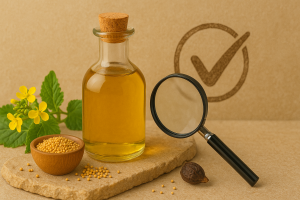Let’s start with a question no one’s asking out loud—is wood pressed mustard oil actually better, or is it just another fancy label slapped on a bottle to charge more? You’ve probably seen it on shelves. The packaging looks rustic. The branding feels traditional. But the price? Not so old-school. If you’re wondering whether to buy it or scroll past, this one’s for you. Let’s dig into what is wood pressed mustard oil, why it’s suddenly everywhere, and whether it’s here to stay or heading for the same shelf as forgotten food trends.
First off, what exactly is it?
Wood pressing is a slow, mechanical extraction process. It uses a wooden churner (usually called a kolhu) to crush mustard seeds at low temperatures. No chemicals. No refining. Just seeds, wood, and pressure. This process pulls out the oil without stripping it of its natural aroma or sharp flavor.
So yes, what is wood pressed mustard oil? It’s oil extracted the old-fashioned way—with patience, muscle, and minimal processing.
Why is it making a comeback now?
Simple answer: people are fed up with over-processed stuff. There’s a growing hunger for things that feel honest. Wood pressed oil fits right in. It taps into nostalgia. It brings back memories of simpler kitchens. The kind where oil was thick, pungent, and had a bite.
Also, let’s not ignore the marketing. It sells the idea of going back to your roots. And that resonates.
Is it really any different from regular mustard oil?

In terms of how it behaves—yes. Wood pressed oil is thicker. It smells stronger. It smokes less when heated. And because it’s not refined, it holds onto all the stuff that usually gets removed during processing. That includes color, scent, and texture.
For cooking? It adds a lot of punch. For pickling? It’s a solid win. For the price? That’s where opinions split.
Is this a recent innovation? Not even close.
Wood pressing has existed for centuries. It’s how oil was made before industrial machines showed up. Your grandparents probably knew someone who owned a kolhu. So no, it’s not new. It just went quiet for a while and now it’s having a moment again.
That doesn’t make it a gimmick. It makes it a cycle.
Does everyone need to switch to it?
Not necessarily. If you’re deep-frying every day, the cost might sting a little. But if you care about flavor, texture, and traditional preparation, it’s a solid investment. Some people buy one bottle just for special dishes. That’s smart. You don’t need to go all in.
Where does this trend go from here?
It depends. If brands stick to small-batch production and real wood pressing, the quality will speak for itself. But if the market floods with shortcuts and “wood pressed” becomes another buzzword with no meaning, it’ll fade.
The good news? You can usually tell the difference. Real wood pressed mustard oil is intense. It doesn’t sit quietly in your dish. It makes its presence known. If it doesn’t, you probably didn’t get the real thing.
So—is it trend or timeless?
It’s both. The technique is old. The attention it’s getting now is fresh. But the value? That’s always been there. It was just waiting for people to rediscover it.
Final thought
Now that you know what is wood pressed mustard oil, the question isn’t whether it’s trendy. The question is whether it works for you. If you like your cooking bold, your ingredients simple, and your pantry a little more honest—maybe it’s time to give it a shot.




